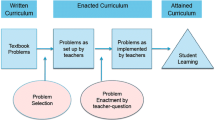Abstract
The role of the mathematics textbook at tertiary level has received limited exposure in previous research although it is likely that students work individually and that some of this work depends on the use of the textbook. The aim of this study was to investigate the process of approaching the textbook from epistemological, cognitive, and didactical perspectives. The focus was on identifying and discussing the opportunities and constraints in the process. The study was an explorative case study and the participants were first-year engineering students taking a basic calculus course. The data were collected through questionnaires, observations, and interviews. Results showed that the textbook was used to a very low degree and mainly perceived as a source of tasks. Different opportunities and constraints are pointed out and some didactical implications are suggested. The results and discussion indicate that a need for greater awareness about the use of mathematical textbooks in meaningful ways at tertiary level.
Similar content being viewed by others
Notes
Rammeplan = studyplan
The university college traditionally enrols many students from Asia.
References
Adams, R.A. (2006, 2003). Calculus. A complete course. Toronto, Canada: Pearson.
Alsina, C. (2001). Why the professor must be a stimulating teacher? In D. Holton (Ed.), The teaching and learning of mathematics at university level: an ICMI Study (pp. 3–12). Dordrecht, The Netherlands: Kluwer Academic Publishers.
Artigue, M. (1994). Didactical engineering as a framework for the conception of teaching products. In R. Biehler, R. W. Scholtz, R. Strasser, & B. Winkelmann (Eds.), Didactics of mathematics as a scientific discipline (pp. 27–39). Dordrecht, The Netherlands: Kluwer Academic Publisher.
Artigue, M. (2001). What can we learn from educational research at the university level? In D. Holton (Ed.), The teaching and learning of mathematics at university level: an ICMI Study (pp. 207–220). Dordrecht, The Netherlands: Kluwer Academic Publisher.
Bryman, A. (2004). Social research methods. Oxford, UK: Oxford University Press.
Dreyfus, T. (1991). Advanced mathematical thinking processes. In D. Tall (Ed.), Advanced mathematical thinking (pp. 25–41). Dordrecht, The Netherlands: Kluwer Academic Publishers.
Eisenberg, T. (1991). Functions and associated learning difficulties. In D. Tall (Ed.), Advanced mathematical thinking (pp. 140–152). Dordrecht, The Netherlands: Kluwer Academic Publishers.
Golden, S. T. (2006). Observation in poverty research. Focus, 24(3), 29–32.
Holton, D. (Ed.). (2001). The teaching and learning of mathematics at university level. Dordrecht, The Netherlands: Kluwer Academic Publishers.
Johansson, M. (2006). Teaching mathematics with textbooks. A classroom and curricular perspective. PhD thesis, Department of Mathematics, Luleå University of Technology.
Juter, K. (2006). Limits of functions. University students’ concept development. PhD thesis, Department of Mathematics, Luleå University of Technology.
Kajander, A., & Lovric, M. (2009). Mathematics textbooks and their potential role in supporting misconceptions. International Journal of Mathematical Education in Science and Technology, 40(2), 173–181.
Kummerer, B. (2001). Trying the impossible. In D. Holton (Ed.), The Teaching and learning of mathematics at university level: an ICMI Study (pp. 321–334). Dordrecht, The Netherlands: Kluwer Academic Publishers.
Lakatos, I. (1976). Proofs and refutations. The logic of mathematical discovery. Cambridge, UK: Cambridge University Press.
Leder, G. C., & Forgasz, H. J. (2002). Measuring mathematical beliefs and their inpact on the learning of mathematics: A new approach. In G. Leder, E. Pehkonen, & G. Toerner (Eds.), Mathematical beliefs and their impact on teaching and learning of mathematics (pp. 95–113). Dordrecht, The Netherlands: Kluwer Academic Publishers.
Lester, F., & Lambdin, D. (1998). The ship of Theseus and other metaphors for thinking about what we value in mathematics. In A. Sierpinska & J. Kilpatrick (Eds.), Mathematics education as a research domain: a search for identity (pp. 415–426). Dordrecht, The Netherlands: Kluwer Academic Publishers.
Niss, M. (1998). Mathematics and mathematics education research, Proceedings ICMU98. Berlin, Germany: University of Berlin Press.
Norway Ministry of Education and Research. (2005). Rammeplan for ingeniørutdanning. Norway: Oslo.
Raman, M. (2002). Coordinating informal and formal aspects of mathematics: students’ behaviour and textbooks messages. Journal of Mathematical Behaviour, 21, 135–150.
Randahl, M., & Grevholm, B. (2010). Learning opportunities offered by a classical calculus textbook to engineering students about differentiation. NOMAD, 15(2), 5–27.
Schoenfeld, F. (2007). Methods. In F. Lester (Ed.), Second handbook of research on mathematics teaching and learning (pp. 69–107). Charlotte, NC: Information Age Publishing.
Sosniak, L. A., & Perlman, C. L. (1990). Secondary education by the book. Journal of Curriculum Studies, 22(5), 427–442.
Tall, D. (1991). The psychology of advanced mathematical thinking. In D. Tall (Ed.), Advanced mathematical thinking (pp. 3–24). Dordrecht, The Netherlands: Kluwer Academic Publishers.
Tall, D., & Vinner, S. (1981). Concept image and concept definition in mathematics with particular reference to limits and continuity. Educational Studies in Mathematics, 12, 151–169.
Tietze, U.-P. (1994). Mathematical curricula and the underlying goals. In R. Biehler, R. W. Scholtz, R. Strässer, & B. Winkelmann (Eds.), Didactics of mathematics as a scientific discipline (pp. 41–53). Dordrecht, The Netherlands: Kluwer Academic Publishers.
Vinner, S. (2007). Mathematics education: procedures, rituals and man’s search for meaning. Journal for Mathematical Behaviour, 26, 1–10.
Wellington, J. (2000). Educational research. Contemporary issues and practical approaches. London, UK: Continuum.
Wood, L. (2001). The secondary-tertiary interface. In D. Holton (Ed.), The Teaching and learning of mathematics at university level: an ICMI Study (pp. 87–98). Dordrecht, The Netherlands: Kluwer Academic Publishers.
Zevenbergen, R. (2001). Changing contexts in tertiary mathematics: Implications for diversity and equity. In D. Holton (Ed.), The Teaching and learning of mathematics at university level (pp. 13–26). Dordrecht, The Netherlands: Kluwer Academic Publishers.
Author information
Authors and Affiliations
Corresponding author
Rights and permissions
About this article
Cite this article
Randahl, M. First-year engineering students’ use of their mathematics textbook - opportunities and constraints. Math Ed Res J 24, 239–256 (2012). https://doi.org/10.1007/s13394-012-0040-9
Received:
Revised:
Accepted:
Published:
Issue Date:
DOI: https://doi.org/10.1007/s13394-012-0040-9



